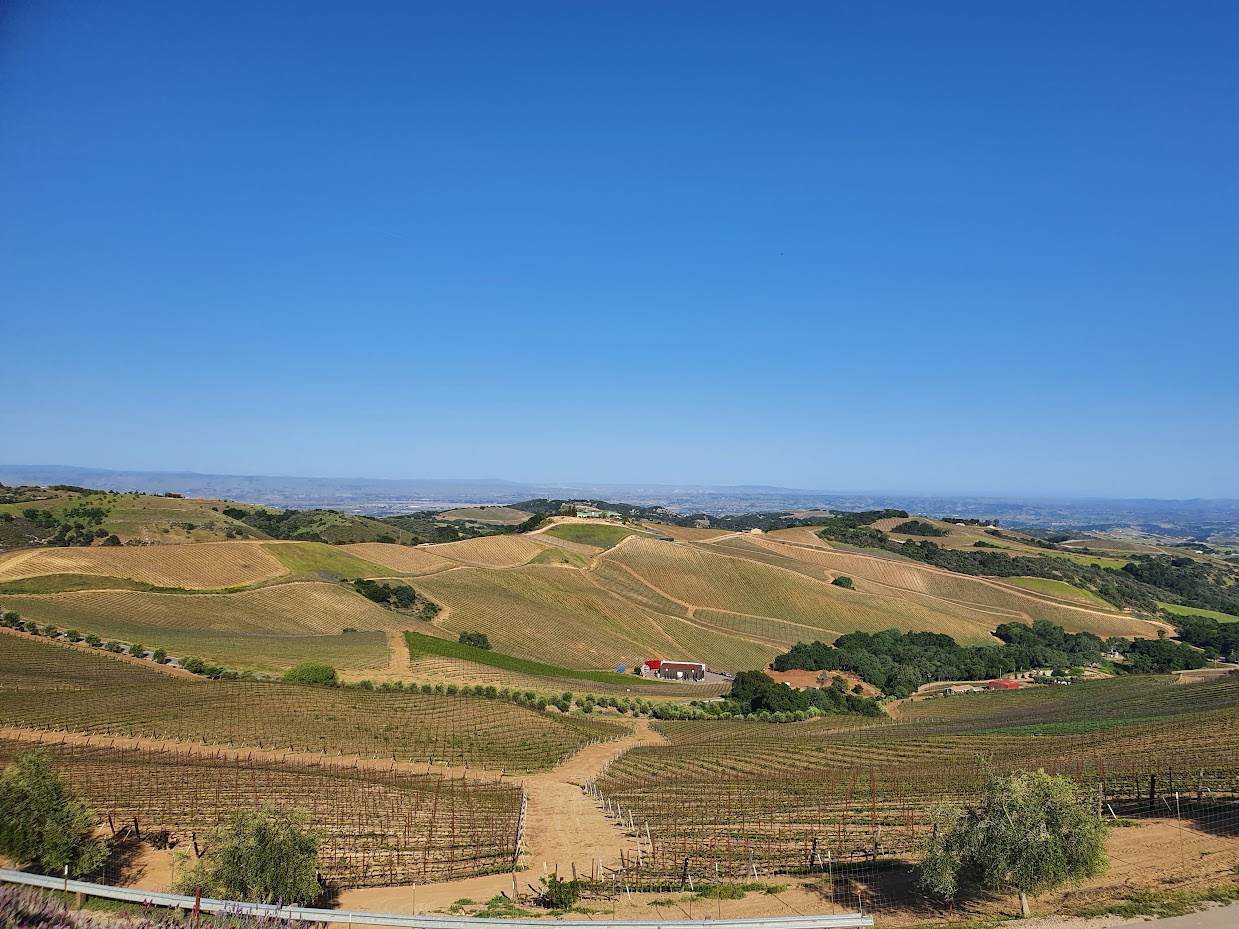Having been to both Paso Robles and Sonoma many times, I can tell you they are quite different. There’s a different pace and way of life in both, for sure, but there’s also quite a difference between their wine experiences.
If you’re a wine lover, you’ve probably heard both because they are two of California’s most famous wine regions. Both offer a unique wine-tasting experience, but they are both quite different as well. In this article, we’ll compare Paso Robles vs. Sonoma to help you decide which wine country destination is the best fit for your taste.

When people ask me to give them the insider’s view into Paso Robles, I always start by saying, imagine what happens when you mix together a bunch of surfers, ranchers, and farmers, with a dash of college town lifestyle.
The result is a laid-back and welcoming atmosphere, perfect for a weekend getaway. With over 200 wineries and 40,000 vineyard acres, Paso Robles has become one of the fastest-growing wine regions in California, known for its bold red blends and Rhône-style varietals. We’ve been there dozens of times and will always go back, because it’s laidback, inviting, and easy.
Sonoma, on the other hand, is one of the oldest and most prestigious wine regions in the world, with over 400 wineries and 60,000 acres of vineyards. It’s located just an hour north of San Francisco. As you can imagine, it gets more visitors than Paso.
Sonoma is known for its diverse range of wine varietals, including Chardonnay, Pinot Noir, and Cabernet Sauvignon. The region is also famous for its sustainable and organic farming practices, which have been adopted by many wineries in the area. 10 years ago, we loved Sonoma the way we now love Paso. It’s changed a lot since then. Not necessarily bad, but different. I’ll explain in more details below.
Geographical Comparison: Paso Robles and Sonoma

When it comes to wine country, both Paso Robles and Sonoma have their own unique geographical features that make them special. Paso Robles is located in Central Coast California, halfway between Los Angeles and San Francisco. The region is surrounded by mountains, and the Pacific Ocean is 40-minutes drive away.
Sonoma is located in Sonoma County, which is just north of San Francisco. The region is known for its rolling hills and the Pacific Ocean is about 60 minutes away by car. If you’re planning a trip to Sonoma County, you’ll likely need to fly into one of the airports near Sonoma.
Paso Robles has a Mediterranean climate, with hot summers and cool winters. The region is known for its thermal springs, which are believed to have healing properties. The area is also home to the iconic Hearst Castle, which is a popular tourist destination.
Sonoma has a cooler climate, being more north. The region is known for its foggy mornings and cool breezes, which help to create the perfect conditions for growing certain types of grapes.
Both Paso Robles and Sonoma have a rich history when it comes to wine. Paso Robles has been producing wine since the 1790s, and the region is known for its Zinfandel, Cabernet Sauvignon, and Rhone-style wines. Sonoma has been producing wine since the 1820s and the region is known for its Pinot Noir, Chardonnay, and Cabernet Sauvignon.
In terms of size, Sonoma is much larger than Paso Robles. Sonoma County covers over 1,500 square miles, while Paso Robles covers just over 600 square miles. However, despite its smaller size, Paso Robles has over 200 wineries, while Sonoma has over 400 wineries.
Wine Varieties and Winemaking

Both Paso Robles and Sonoma are known for producing high-quality wines using different grape varieties and winemaking techniques.
Paso Robles wine region is known for producing full-bodied red wines:
- Cabernet Sauvignon
- Zinfandel
- Syrah
- Cabernet Franc
- Petit Verdot
- Malbec
Sonoma has a cooler climate, ideal for growing Pinot Noir and Chardonnay. It’s known for:
- Pinot Noir
- Chardonnay
- Zinfandel
- Sauvignon Blanc
- Sparkling wines
- Grenache
- Syrah
- Viognier
Both regions have their own unique winemaking techniques. Paso Robles is known for its use of oak barrels, which adds complexity and depth to its wines. Sonoma is known for its use of stainless steel tanks, which preserves the fruit flavors and aromas of its wines.
Wine Tasting and Touring Experience

The wine-tasting and touring experience differs a bit between the two regions. This is one of the reasons we enjoy Paso now more than Sonoma.
Paso Robles has many wineries open for tasting without an appointment and an average tasting fee of $10-15, with many concentrated on the Highway 46 corridor. You can enjoy a more laid-back and casual wine tasting experience, with many family-owned wineries.
Sonoma County has more wineries, but many require reservations and charge tasting fees ranging from $20 to $50. Gone are the days when you could just stop by a winery and enjoy a tasting without breaking the bank.
We used to think of Sonoma as Napa’s little sister, where the tasting experience was still laidback and casual. Now it’s a more sophisticated and upscale wine tasting experience, with many boutique wineries offering high-end wines and food pairings.
Keep in mind that both regions can experience heavy traffic during peak season, especially on weekends. If you’re planning to visit, it’s recommended to book lodging and make reservations in advance. You can also consider using Uber or other transportation services to avoid traffic jams and enjoy the wine tasting experience to the fullest.
Frequently Asked Questions
What are some of the top wineries to visit in Paso Robles and Sonoma?
Paso Robles and Sonoma are both home to numerous award-winning wineries. Some of the top wineries to visit in Paso Robles include Tablas Creek Vineyard, Justin Vineyards & Winery, Daou, and Adelaida Cellars. In Sonoma, you may want to check out Chalk Hill Vineyards, Rodney Strong, Frances Ford Coppola, Ridge Vineyards, Kistler Vineyards, and Williams Selyem.
Which region produces better Cabernet Sauvignon, Paso Robles or Sonoma?
Both Paso Robles and Sonoma produce excellent Cabernet Sauvignon wines. However, Paso Robles is known for producing Cabernet Sauvignon with bold, intense flavors, while Sonoma’s Cabernet Sauvignon is known for being more refined and elegant.
What are the main differences between the wine regions of Paso Robles and Sonoma?
Paso Robles is known for its warm, dry climate and diverse terroir, which allows for a wide range of grape varietals to be grown. Sonoma has a cooler climate and is known for producing high-quality Chardonnay and Pinot Noir wines. Additionally, Paso Robles has a more laid-back, rural vibe, while Sonoma is known for its upscale wine country experience.
Is Paso Robles a good alternative to Napa for wine tasting?
Yes, Paso Robles is a great alternative to Napa for wine tasting. Paso Robles has a more relaxed atmosphere and is less crowded than Napa, making it a great option for those looking for a more intimate wine tasting experience. Additionally, Paso Robles is home to a wide variety of wineries, including many boutique wineries that are not found in Napa. And finally, the prices for wine are considerably less in Paso Robles than in Napa.
Which wine country is more budget-friendly, Paso Robles or Sonoma?
Paso Robles is generally considered to be more budget-friendly than Sonoma. While both regions have wineries that offer tastings for a range of prices, Paso Robles has a larger number of wineries with lower-priced tastings. Additionally, Paso Robles has a more laid-back atmosphere, which can translate to lower overall costs for visitors.

Laura is a travel fanatic who loves seeing and doing new things. She lives in Ventura, CA, and spends a lot of time exploring California’s cities, beaches, and national parks.
